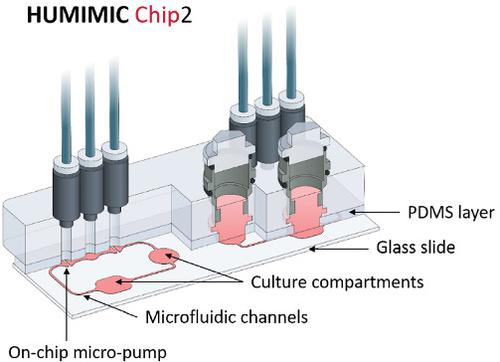当前位置:
X-MOL 学术
›
Drug Test. Anal.
›
论文详情
Our official English website, www.x-mol.net, welcomes your
feedback! (Note: you will need to create a separate account there.)
Organ-on-a-chip: Determine feasibility of a human liver microphysiological model to assess long-term steroid metabolites in sports drug testing
Drug Testing and Analysis ( IF 2.6 ) Pub Date : 2021-09-10 , DOI: 10.1002/dta.3161 Christian Görgens 1 , Anja Patricia Ramme 2 , Sven Guddat 1 , Yvonne Schrader 1 , Annika Winter 2 , Eva-Maria Dehne 2 , Reyk Horland 2 , Mario Thevis 1, 3
Drug Testing and Analysis ( IF 2.6 ) Pub Date : 2021-09-10 , DOI: 10.1002/dta.3161 Christian Görgens 1 , Anja Patricia Ramme 2 , Sven Guddat 1 , Yvonne Schrader 1 , Annika Winter 2 , Eva-Maria Dehne 2 , Reyk Horland 2 , Mario Thevis 1, 3
Affiliation

|
A fundamental challenge in preventive doping research is the study of metabolic pathways of substances banned in sport. However, the pharmacological predictions obtained by conventional in vitro or in vivo animal studies are occasionally of limited transferability to humans according to an inability of in vitro models to mimic higher order system physiology or due to various species-specific differences using animal models. A more recently established technology for simulating human physiology is the “organ-on-a-chip” principle. In a multichannel microfluidic cell culture chip, 3-dimensional tissue spheroids, which can constitute artificial and interconnected microscale organs, imitate principles of the human physiology. The objective of this study was to determine if the technology is suitable to adequately predict metabolic profiles of prohibited substances in sport. As model compounds, the frequently misused anabolic steroids, stanozolol and dehydrochloromethyltestosterone (DHCMT) were subjected to human liver spheroids in microfluidic cell culture chips. The metabolite patterns produced and circulating in the chip media were then assessed by LC-HRMS/(MS) at different time points of up to 14 days of incubation at 37°C. The overall profile of observed glucurono-conjugated stanozolol metabolites excellently matched the commonly found urinary pattern of metabolites, including 3′OH-stanozolol-glucuronide and stanozolol-N-glucuronides. Similarly, but to a lower extent, the DHCMT metabolic profile was in agreement with phase-I and phase-II biotransformation products regularly seen in postadministration urine specimens. In conclusion, this pilot study indicates that the “organ-on-a-chip” technology provides a high degree of conformity with traditional human oral administration studies, providing a promising approach for metabolic profiling in sports drug testing.
中文翻译:

芯片上的器官:确定人类肝脏微生理模型在运动药物测试中评估长期类固醇代谢物的可行性
预防性兴奋剂研究的一个基本挑战是研究运动中禁用物质的代谢途径。然而,根据体外模型无法模拟更高阶系统生理学或由于使用动物模型的各种物种特异性差异,通过常规体外或体内动物研究获得的药理学预测有时对人类的可转移性有限。最近建立的一种模拟人体生理学的技术是“芯片上的器官”原理。在多通道微流控细胞培养芯片中,3 维组织球体可以构成人工和互连的微型器官,模仿人体生理学原理。本研究的目的是确定该技术是否适合充分预测运动中违禁物质的代谢特征。作为模型化合物,经常被滥用的合成代谢类固醇、康力龙和脱氢氯甲基睾酮 (DHCMT) 在微流控细胞培养芯片中被用于人肝球体。然后通过 LC-HRMS/(MS) 在 37°C 下孵育长达 14 天的不同时间点评估芯片培养基中产生和循环的代谢物模式。观察到的葡萄糖醛酸结合康力龙代谢物的总体特征与常见的代谢物尿液模式非常匹配,包括 3'OH-康力龙-葡萄糖醛酸和康力龙- 康力龙和脱氢氯甲基睾酮 (DHCMT) 在微流控细胞培养芯片中被用于人肝球体。然后通过 LC-HRMS/(MS) 在 37°C 下孵育长达 14 天的不同时间点评估芯片培养基中产生和循环的代谢物模式。观察到的葡萄糖醛酸结合康力龙代谢物的总体特征与常见的代谢物尿液模式非常匹配,包括 3'OH-康力龙-葡萄糖醛酸和康力龙- 康力龙和脱氢氯甲基睾酮 (DHCMT) 在微流控细胞培养芯片中被用于人肝球体。然后通过 LC-HRMS/(MS) 在 37°C 下孵育长达 14 天的不同时间点评估芯片培养基中产生和循环的代谢物模式。观察到的葡萄糖醛酸结合康力龙代谢物的总体特征与常见的代谢物尿液模式非常匹配,包括 3'OH-康力龙-葡萄糖醛酸和康力龙-N-葡糖苷酸。同样,但在较低程度上,DHCMT 代谢特征与给药后尿液样本中常见的 I 期和 II 期生物转化产物一致。总之,这项初步研究表明,“芯片上的器官”技术与传统的人类口服给药研究高度一致,为运动药物测试中的代谢分析提供了一种有前景的方法。
更新日期:2021-09-10
中文翻译:

芯片上的器官:确定人类肝脏微生理模型在运动药物测试中评估长期类固醇代谢物的可行性
预防性兴奋剂研究的一个基本挑战是研究运动中禁用物质的代谢途径。然而,根据体外模型无法模拟更高阶系统生理学或由于使用动物模型的各种物种特异性差异,通过常规体外或体内动物研究获得的药理学预测有时对人类的可转移性有限。最近建立的一种模拟人体生理学的技术是“芯片上的器官”原理。在多通道微流控细胞培养芯片中,3 维组织球体可以构成人工和互连的微型器官,模仿人体生理学原理。本研究的目的是确定该技术是否适合充分预测运动中违禁物质的代谢特征。作为模型化合物,经常被滥用的合成代谢类固醇、康力龙和脱氢氯甲基睾酮 (DHCMT) 在微流控细胞培养芯片中被用于人肝球体。然后通过 LC-HRMS/(MS) 在 37°C 下孵育长达 14 天的不同时间点评估芯片培养基中产生和循环的代谢物模式。观察到的葡萄糖醛酸结合康力龙代谢物的总体特征与常见的代谢物尿液模式非常匹配,包括 3'OH-康力龙-葡萄糖醛酸和康力龙- 康力龙和脱氢氯甲基睾酮 (DHCMT) 在微流控细胞培养芯片中被用于人肝球体。然后通过 LC-HRMS/(MS) 在 37°C 下孵育长达 14 天的不同时间点评估芯片培养基中产生和循环的代谢物模式。观察到的葡萄糖醛酸结合康力龙代谢物的总体特征与常见的代谢物尿液模式非常匹配,包括 3'OH-康力龙-葡萄糖醛酸和康力龙- 康力龙和脱氢氯甲基睾酮 (DHCMT) 在微流控细胞培养芯片中被用于人肝球体。然后通过 LC-HRMS/(MS) 在 37°C 下孵育长达 14 天的不同时间点评估芯片培养基中产生和循环的代谢物模式。观察到的葡萄糖醛酸结合康力龙代谢物的总体特征与常见的代谢物尿液模式非常匹配,包括 3'OH-康力龙-葡萄糖醛酸和康力龙-N-葡糖苷酸。同样,但在较低程度上,DHCMT 代谢特征与给药后尿液样本中常见的 I 期和 II 期生物转化产物一致。总之,这项初步研究表明,“芯片上的器官”技术与传统的人类口服给药研究高度一致,为运动药物测试中的代谢分析提供了一种有前景的方法。











































 京公网安备 11010802027423号
京公网安备 11010802027423号